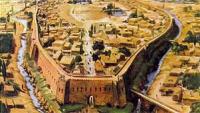You are here
Ruins ancient of Afrasiab.


Great cities Central Asia and Uzbekistan.
“Everything I heard about Samarkand is true, except the fact that it is much more beautiful than I could imagine”
The Greek king.
Excursion to Afrasiab ancient settlement in Samarkand.
The ancient settlement of Afrasiab is situated on the spurs of Chupan-Ata hills to the north-east of present-day Samarkand. According to the legend, it was here, on the banks of the river Siab, that Turanian king and hero Afrasiab, a character of the folk epic ‘Shahnama’, founded the town that became the capital of Sogdiana.
The first excavations on Afrasiab site took place at the end of the XIX century. From the mid - XX century the systematic research archeological activities have been carried out on the site. The examination of the cultural strata, which was recently conducted by Uzbek and French archeologists and orientalists, revealed that in the northern part of the site, at a depth of 10 - 15 meters, as far back as the IX – VIII centuries BC there existed a large settlement with a strong citadel, a palace, residential buildings, utility structures, and temples.
It was surrounded by an 8-meter-thick fortification wall made of adobe blocks. One could get into the palace only through a long slanting passageway in the wall, which in the ancient times had guards all along its length. The analysis of ceramics and other finds discovered during the excavations allowed to conclude that Samarkand is at least 2750 years old, the first written mention of Samarkand is traced in the holy Zoroastrian book ‘Avesta’.
Within twenty centuries of their existence the citadel and the palace were rebuilt a number of times.
From the top of the citadel one gets a panoramic view of the ancient city. There come into view the outlines of street network and artisan quarters with extant parts of the clay kilns and production dumps of glass-blowers, blacksmiths and potters.
The four circles of mighty defensive walls with weather-beaten wattle-and-daub turrets can be clearly seen. The first line of the walls dates back to Hellenistic period in the city’s history. These ruins remember the siege by Alexander the Great in 329 BC.
The following are the words of the Greek king: “Everything I heard about Samarkand is true, except the fact that it is much more beautiful than I could imagine”. Archeologists discovered a lot of bronze and ceramic articles, ossuaries, gems, coins, jewelry and bowls dating to that period of time.
Even today, at the sites of old digs, an intent visitor can find various artifacts, as for instance a terracotta statuette of Zoroastrian goddess of fertility Anahita, or a Greek-Bactrian coin. The second and third lines of the walls with traps and moats were built early in the Middle Ages.
As early as the first centuries of Common Era, Samarkand became a large center of international trade. Even the names of the gates in the double walls – Bukhara Gate, Kesh Gate, China Gate – pointed at the destinations of Samarkand’s ancient trade roads.
Another gate was built near Buddhist vihara temple and was called Naubehar Gate. At the foot of the citadel archeologists discovered the palace of Sogdiana’s sovereign ishkhid Varhuman. In the throne-room of the palace, along its perimeter, there were elevations for the courtiers; its walls were decorated with multicolor murals depicting scenes of hunts for wild animals, battle scenes, dressy men and women atop elephants, camels and horses.
The central painting showed a reception of embassies from various countries; here the dress of one of the characters contains an inscription in the Sogdian language - Chaganian ruler’s friendly greeting for the ruler of Sogd. Alongside with other artifacts, these paintings, with great care taken out by the experts, are now on display in Afrosiab History Museum located on one of Afrosiab hills.
In 712 Samarkand was captured by the Arabs led by Kuteiba ibn Muslim, and was designated the residence of Caliph’s governor in Movarounnakhr. Archeological excavations revealed the citadel- kuhendiz with Samanid royal palace, decorated with a gunch stucco carvings. In the inner town area -shakhristan there remained some parts of the madrassahs, caravanserais, bathhouses, residential areas and artisan quarters, ruins of multicolumn Friday mosque, which had been built on the foundation of the former temple of fire-worshippers.
Archeologists also discovered remains of the aqueduct that had fed Samarkand with water. The fourth line of the walls, with indented turrets and parapets, surrounded the rabad suburb which had arisen round shakhristan area.
These walls encircled the area of over 220 hectares and had twelve double gates.
In the IX - XII centuries Samarkand reached its golden age. According to Istarhi, an Arabian geographer of the X century, Samarkand was a land harbor of Movarounnahr; its bazaars were multilingual, the variety of merchandise was fabulous. No wonder Samarkand was granted the honorary title of “the Heart of the Great Silk Road”.
In 1220 Ginghis Khan’s warriors took Samarkand by storm, plundered it and burnt it down. Eventually its residents began to rebuild the town, not on the ashes of shakhristan inner town, though, but in the rabad suburb, where in the 14th century they started to develop the center of Temur’s Samarkand.
Authority:
« Religious and spiritual monuments of the Central Asia ». The author of M. Khashimov. Publishing house " Saga ", 2001







